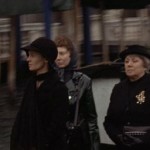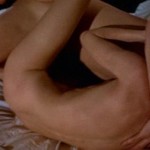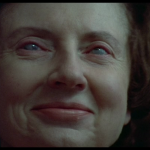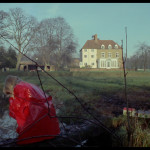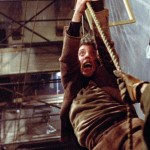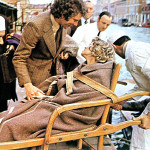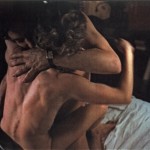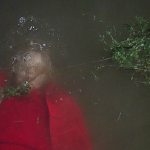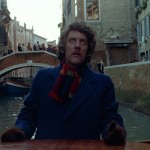Nic Roeg‘s infamous Don’t Look Now came out in 1973, though I did not see it for the first time until the 6th Form Film Club four or five years later, by which time it had earned its fair share of notoriety.
Why notoriety, you may justifiably ask? After all, this is essentially one supernatural thriller or horror film (take your pick and pigeonhole accordingly) among many. Sure, it features a good cast, not to mention some very spooky views of Venice, a city more closely associated with tourists, canals and gondolas, charming and romantic views of the Bridge of Sighs (actually used to transport criminals from the courts to the cells), Italian food and Renaissance masterpieces like those of Titian. Great, but hardly enough to make this movie the stuff of legend, you might say, so what is different to a thousand others?
Firstly there was that sex scene, the one featuring Donald Sutherland and Julie Christie. By the prudish standards of the time it was a tad racy, more graphic than you had any right to expect, even if with the benefit of hindsight it seems relatively run of the mill. The buzz going round at the time was that they were really, you know, doing it for real (shock horror!) I suspect that was just the marketing team putting out a rumour to set tongues wagging and box office tills ringing, but it gave the movie a reputation that might otherwise be lacking (see full story from Wikipedia at the bottom.)
Then there was the subject matter, bearing in mind that more people believed in spiritualism, not to mention the devil in those days. With hindsight it is a piece of fiction, adapted from a short story by Daphne du Maurier, but at the time it felt almost dangerous, playing with fire – but then the supernatural became all the rage. This was after all the decade that gave us The Exorcist, The Omen, The Mephisto Waltz and many more of the same ilk. The supernatural took people out of their comfort zone.
Yet, as Wikipedia points out:
“…its reputation has grown considerably in the years since, and it is now acknowledged as a modern classic and an influential work in horror and British film.”
The reality is that Don’t Look Now was hugely influential for being a highly innovative and supremely crafted movie, one that stands repeated viewings with the promise of finding new aspects – always the mark of a great movie, in my estimation.
The plot is arguably the most conventional aspect of the film, though irrespective of the horror and thriller elements it holds its own as a character study on the psychological effects of grief and guilt on two affluent professional parents who have lost their daughter to a terrible and preventable accident. Their relationship remains loving but is never quite the same again, and the grief drives their actions, sucks from them their joie de vivre, yet fuels a strange unspoken hope.
The opening scenes in which Sutherland’s John Baxter realises that young Christine is missing, runs to find her drowned in the lake at the far end of their garden and is consumed by an impotent rage reminiscent of de Niro in Raging Bull are affecting and effective.
The red mac worn by young Christine (Sharon Williams) becomes a motif throughout the movie, later copied by Spielberg in Schindler’s List – as does the water, giving Baxter an ambiguous relationship with the city of Venice, and the fear of falling – which he very nearly does when a scaffold collapses in Venice. The use of the red motif is not entirely successful – I found the blood oozing over a slide of the church to be overkill, yet the camera lingers long over that image.
This was one of several scenes prompting critics to associate the movie with the art house movement and to imply that it was pretentious and overblown. The fact that DLN has withstood the test of time and become far more than a cult classic suggests there is something far more compelling in the tale – and the fact is that it has much more to do with the untapped potential of the human mind (NB. Carrie came out 3 years after DLN) and how it plays tricks than ever it does about occult. The latter is implied but not proven, its point being to unsettle the precarious relationship between the married couple.
Baxter and his wife Laura (Christie) take a trip to Venice as part of their recovery process. Baxter, an architect with expertise in the restoration of old buildings, accepts a commission to restore a church. His wife meets two English sisters (Hilary Mason and Clelia Matania), one blind but psychic who claims to see and hear their daughter; Laura believes her but John rejects this news but later finds himself having strange visions he cannot explain – glimpses of what appears to be his daughter in the red mac against the backdrop of an increasingly eerie and menacing Venice by night. The frequent mistaken identity and misinterpretation of what he sees is a predominant theme, leading to an inevitable climax in which the truth is revealed.
The denouement to the movie is well known but I won’t provide any other spoilers, which means I can’t explain the role of Adelina Poerio, who provides a neat twist worthy of the Usual Suspects and the Sixth Sense – which in some ways can be seen as one of many films influenced by Don’t Look Now.
What I will say is that Roeg’s application of his cinematographic craft to create enduring tension, including nods to Hitchcock, succeeds, such that he can manipulate his audience in ways that the master would have greatly approved.
One such is the intercutting of flashbacks and flash forwards, initially confusing for the audience who are seeing the world through John’s eyes, but gradually realise where he does not that his visions are premonitions.
The same technique is used through the scene where John and Laura make love – we see them in the throes of passion while simultaneously getting dressed and preparing to go out, as if their minds are somewhere else during the act. Yet the very intimacy is claustrophobic; along with the opening death scene it creates a depth of personal intensity that singles out DLN from run-of-the-mill horror pics and helps us to know John and Laura, understand their motivations.
Credit too to the cast for slightly underplaying their roles, leaving space for the audience to fill in the blanks. There is nothing worse for an audience than a director who insists on dotting the I’s and crossing the T’s while allowing his cast to descend into melodramatic hysteria, certainly common in horror films bordering on the supernatural.
The portrayal of the darker side of Venice is hugely effective, such that it becomes as much a quintessential character to the mechanics of plot as it does in a very different and more romantically poetic way in Visconti‘s telling of Thomas Mann‘s novella Death in Venice.
There is very much to admire about Don’t Look Now. It is flawed but one of several substantial achievements in the fine career of Nicholas Roeg. If you have not yet seen the movie, I recommend it – not least because you will find therein a key influence in the development of the genre and for many films and performances that followed. What I will remember most is that the impact of grief and trauma was never portrayed any better on screen.
__________
Don’t Look Now has become famous for a sex scene involving Julie Christie and Donald Sutherland, which caused considerable controversy prior to its release in 1973. British tabloid newspaper, the Daily Mail, observed at the time “one of the frankest love scenes ever to be filmed is likely to plunge lovely Julie Christie into the biggest censorship row since Last Tango in Paris“. The scene was unusually graphic for the period, including a rare depiction of cunnilingus in a mainstream film.
Christie commented that “People didn’t do scenes like that in those days”, and that she found the scenes difficult to film: “There were no available examples, no role models … I just went blank and Nic [Roeg] shouted instructions.” The scene caused problems with censors on both sides of the Atlantic. The American censor advised Nicolas Roeg explicitly that “We cannot see humping. We cannot see the rise and fall between thighs.” The scene’s much celebrated fragmented style, in which scenes of the couple having sexual intercourse are intercut with scenes of the couple post-coitally getting dressed to go out to dinner, partly came about through Roeg’s attempt to accommodate the concerns of the censors: “They scrutinised it and found absolutely nothing they could object to. If someone goes up, you cut and the next time you see them they’re in a different position, you obviously fill in the gaps for yourself. But, technically speaking, there was no ‘humping’ in that scene.” In the end, Roeg only cut nine frames from the sequence, and the film was awarded an R rating in the United States. In Britain, the British Board of Film Classification judged the uncut version to be “tasteful and integral to the plot”, and a scene in which Donald Sutherland’s character can be clearly seen performing oral sex on Christie’s character was permitted, but it was still given an X rating—an adults only certificate.
The sex scene remained controversial for some years after the film’s release. The BBC cut it altogether when Don’t Look Now premiered on UK television, causing a flood of complaints from viewers. The intimacy of the scene led to rumours that Christie and Sutherland had unsimulated sex which have persisted for years, and that outtakes from the scene were doing the rounds in screening rooms. Michael Deeley, who oversaw the film’s UK distribution, claimed on BBC Radio 4‘s Desert Island Discs that Warren Beatty had flown to London and demanded that the sex scene—featuring then girlfriend Julie Christie—be cut from the film. The rumours were seemingly confirmed in 2011 by former Variety editor Peter Bart, who was a Paramount executive at the time. In his book, Infamous Players: A Tale of Movies, the Mob, (and Sex), Bart says he was on set on the day the scene was filmed and could clearly see Sutherland’s penis “moving in and out of” Christie. Bart also reiterated Warren Beatty’s discontent, noting that Beatty had contacted him to complain about what he perceived to be Roeg’s exploitation of Christie, and insisting that he be allowed to help edit the film. Sutherland subsequently issued a statement through his publicist stating that the claims were not true, and that Bart did not witness the scene being filmed. Peter Katz, the film’s producer, corroborated Sutherland’s account that the sex was entirely simulated.


